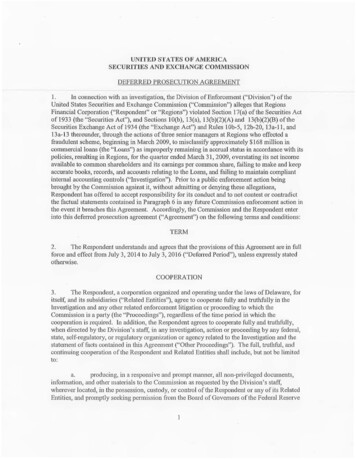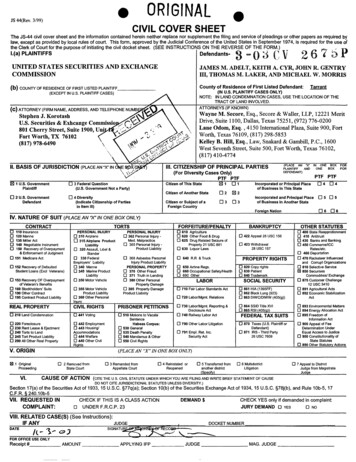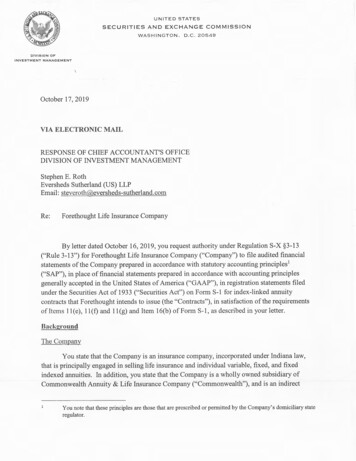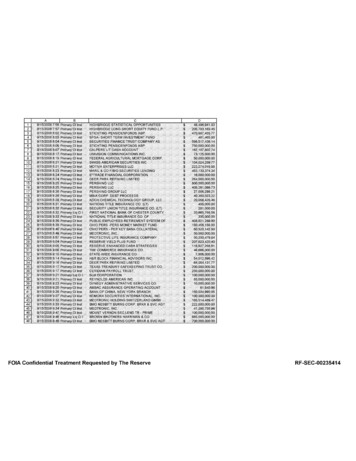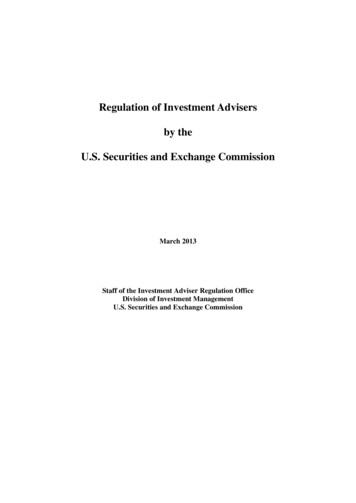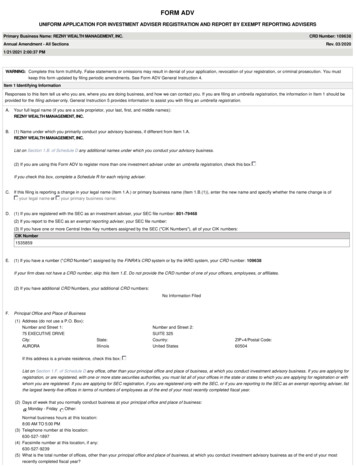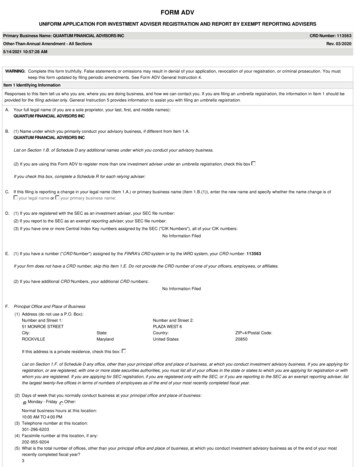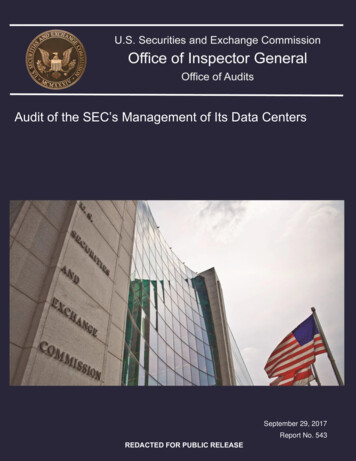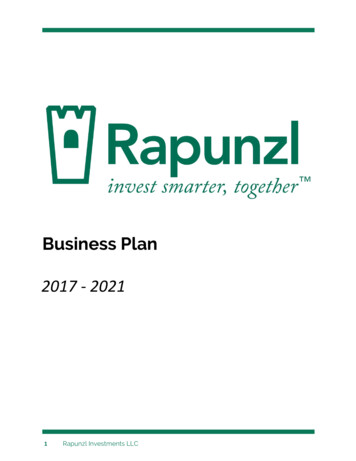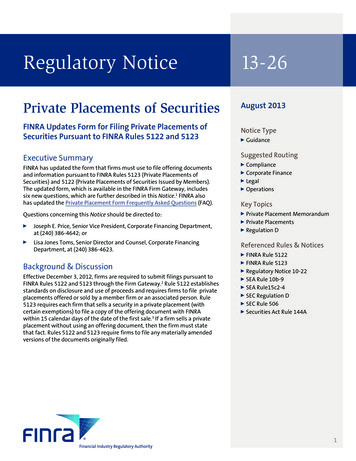
Transcription
Regulatory Notice13-26Private Placements of SecuritiesAugust 2013FINRA Updates Form for Filing Private Placements ofSecurities Pursuant to FINRA Rules 5122 and 5123Notice TypeExecutive SummarySuggested RoutingFINRA has updated the form that firms must use to file offering documentsand information pursuant to FINRA Rules 5123 (Private Placements ofSecurities) and 5122 (Private Placements of Securities Issued by Members).The updated form, which is available in the FINRA Firm Gateway, includessix new questions, which are further described in this Notice.1 FINRA alsohas updated the Private Placement Form Frequently Asked Questions (FAQ).Questions concerning this Notice should be directed to:00Joseph E. Price, Senior Vice President, Corporate Financing Department,at (240) 386-4642; or00Lisa Jones Toms, Senior Director and Counsel, Corporate FinancingDepartment, at (240) 386-4623.00GuidanceComplianceCorporate Finance00 Legal00 Operations0000Key TopicsPrivate Placement MemorandumPrivate Placements00 Regulation D0000Referenced Rules & NoticesFINRA Rule 5122FINRA Rule 512300 Regulatory Notice 10-2200 SEA Rule 10b-900 SEA Rule15c2-400 SEC Regulation D00 SEC Rule 50600 Securities Act Rule 144A00Background & DiscussionEffective December 3, 2012, firms are required to submit filings pursuant toFINRA Rules 5122 and 5123 through the Firm Gateway.2 Rule 5122 establishesstandards on disclosure and use of proceeds and requires firms to file privateplacements offered or sold by a member firm or an associated person. Rule5123 requires each firm that sells a security in a private placement (withcertain exemptions) to file a copy of the offering document with FINRAwithin 15 calendar days of the date of the first sale.3 If a firm sells a privateplacement without using an offering document, then the firm must statethat fact. Rules 5122 and 5123 require firms to file any materially amendedversions of the documents originally filed.001
13-26August 2013In Regulatory Notice 10-22, FINRA provided guidance on the scope of a firm’s responsibilityto conduct a reasonable investigation of the private placement issuer. As described inthat Notice, the amount and nature of the investigation required depends, among otherfactors, upon the nature of the recommendation, the role of the firm in the transaction, itsknowledge of and relationship to the issuer, and the size and stability of the issuer. Eachfirm must make a determination of the scope of its investigation based upon the facts andcircumstances. In general, however, a firm may not rely upon the information provided bythe issuer or its counsel in lieu of conducting its own reasonable investigation.4Private Placement FormOn July 1, 2013, FINRA began using an updated Private Placement Form that includessix new questions that the firm making the filing must answer based on informationcontained in the offering document or if otherwise known by the firm completing the form.Firms participating in private placements often have information beyond what is disclosedin offering documents as a result of their suitability investigations or other reviews.However, to the extent a firm does not otherwise have knowledge that is responsive to aquestion, the form does not require firms to seek out the answers to the question. Rather,the filing broker-dealer can answer “yes,” “no” or “unknown.”5 When a firm has obtainedinformation in its investigation of the private placement issuer such that the answers tothe questions are known to the firm making the filing, they must be completed with a“yes” or “no” answer.6FINRA has added the following six questions to the form:00Is this a contingency offering?00Does the user have any independently audited financial statements for the issuer’smost recent fiscal year?00Is the issuer able to use offering proceeds to make or repay loans to, or purchase assetsfrom, any officer, director or executive management of the issuer, sponsor, generalpartner, manager, advisor or any of the issuer’s affiliates?00Does the issuer have a board of directors comprised of a majority of independentdirectors or a general partner that is unaffiliated with the firm?00Has the issuer engaged, or does the member anticipate that the issuer will engage,in a general solicitation in connection with the offering or sale of the securities?00Has the issuer, any officer, director or executive management of the issuer, sponsor,general partner, manager, advisor, or any of the issuer’s affiliates been the subject ofSEC, FINRA, or state disciplinary actions or proceedings or criminal complaints withinthe last 10 years?The form also asks firms to select an industry category for the specified private placement.See Attachment A for a copy of the form.2Regulatory Notice
August 2013Review PrioritiesThe form assists FINRA in prioritizing its review of private placement filings. Thequestions are not intended to set new standards of disclosure, due diligence or informationgathering requirements for firms involved in the private placement offerings. Examplesof information that can affect our review prioritization include the following:00The private placement is a contingency offering in which no escrow agent is used, oran escrow agent that is used does not comply with Rule 15c2-4 under the SecuritiesExchange Act of 1934 (SEA). Many private placements are conducted as best effortscontingency offerings that must comply with various SEC rules, including SEA Rules10b-9 and 15c2-4. SEA Rule 15c2-4 requires any broker-dealer that participates in a bestefforts contingency offering to appoint a bank as escrow agent or deposit funds in asegregated bank account.00An auditor has questioned whether the issuer can continue as a going concern.00The offering is for interests in a pooled investment fund, the terms of which do notlimit the use of offering proceeds to make or repay loans to, or purchase assets from,any insiders of the fund. Approximately 25 percent of SEC Rule 506 issuers are pooledinvestment funds.700The issuer, any officer, director or executive management, sponsor, general partner,manager, advisor or its affiliate has a relevant disciplinary history. This is true whetheror not the relevant disciplinary history would disqualify the issuer from engaging in anSEC Regulation D offering.800In addition, some information may raise questions about the quality of the suitabilityanalysis that the firm may have conducted.00To assist firms, FINRA is providing additional guidance in the Private Placement FormFAQ.9 See Attachment B for a copy of the FAQ.Regulatory Notice313-26
13-26August 2013Endnotes1.See Securities Exchange Act Release No. 69843(June 25, 2013); 78 FR 39367 (July 1, 2013)(Notice of Filing and Immediate Effectivenessof File No. SR-FINRA-2013-026).2.FINRA Firm Gateway is an online compliancetool that provides consolidated access to FINRAapplications and allows firms to submit requiredfilings electronically to meet their complianceand regulatory obligations.3.This 15-day time period corresponds with thefiling requirement for issuers under SEC FormD. See SEC Form D (Notice of Exempt Offeringof Securities) General Instructions (“An issuermust file a new notice with the SEC for each newoffering of securities no later than 15 calendardays after the ‘date of first sale’ of securitiesin the offering ”).4.See, e.g., District Business Conduct Committeefor District No. 4 v. Everest Securities, Inc., 1994NASD Discip. LEXIS 188 (Sept. 2, 1994), aff’d, 52S.E.C. 958, 962-63 (Aug. 26, 1996), aff’d, 116 F.3d1235, 1239 (8th Cir. 1997) (“reliance on othersdoes not excuse [the respondents’] own lack ofinvestigation”).5.Since filers began using the new form on July1, 2013, on average, 18 percent of filers haveanswered “unknown” to at least one of the sixquestions. Approximately 28 percent of filershave answered “unknown” to the questionregarding whether the issuer, any officer,director or executive management of the issuer,sponsor, general partner, manager, advisor orany of the issuer’s affiliates has been the subjectof SEC, FINRA, or state disciplinary actions orproceedings or criminal complaints within thelast 10 years. Approximately 8 percent haveanswered “unknown” to the question regardingwhether the issuer has independently auditedfinancial statements available for the issuer’smost recent fiscal year.6.Rule 5123 requires firms to “provide FINRAwith the required documents or notificationand related information, if known, by filingan electronic form in the manner prescribedby FINRA.” Filing information a firm knows isinaccurate would violate that requirement.7.See Vladimir Ivanov and Scott Bauguess, CapitalRaising in the U.S.: An Analysis of UnregisteredOfferings Using the Regulation D Exemption,2009 - 2012 (July 2013), at 14, 19-20.8.See Securities Act Release No. 9414 (July10, 2013), 78 FR 44730 (July 24, 2013)(Disqualification of Felons and Other “BadActors” from Rule 506 offerings).9.Concurrently with this Notice, FINRA ispublishing a revised version of the Sale of PrivatePlacements Frequently Asked Questions, whichincludes a section on the new filing questions,to provide members with further clarificationon the purpose and scope of these questions.The Sale of Private Placements FrequentlyAsked Questions can be found on FINRA’swebsite at s/PrivatePlacements/. 2013 FINRA. All rights reserved. FINRA and other trademarks of the Financial Industry Regulatory Authority, Inc.may not be used without permission. Regulatory Notices attempt to present information to readers in a formatthat is easily understandable. However, please be aware that, in case of any misunderstanding, the rule languageprevails.4Regulatory Notice
Attachment A
August 2013Attachment BPrivate Placement Form Frequently Asked Questions (FAQ)Beginning July 1, 2013, FINRA implemented an updated private placement form thatincludes six new questions, which require the firm making the filing to answer “yes,” “no”or “unknown” based on information contained in the offering document or otherwiseknown by the firm making the filing. FINRA is providing the following FAQ regarding theform and updated questions.1. The form asks whether the offering being filed is a contingency offering. What is a“contingency offering?”For purposes of the form, a contingency offering is a private placement in whichthe actual closing or sale of securities in the private placement is contingent on anevent, typically the receipt of orders for a minimum aggregate amount of securitiesby an expiration date. Filers participating in contingencey offerings must familiarizethemselves with, and follow, the relevant SEC rules, including Rules 15c2-4 and 10b-9under the Securities Exchange Act of 1934.2. When a firm completes the form and files offering documents on behalf of itselfand other firms that are participating in the same offering, must the answers to theform’s questions be based on the knowledge of all the firms or only the firm filingthe form?The form provides that the firm submitting the filing must answer the questions “[b]ased on the information contained in the offering document (or if otherwise knownby your firm).” The firm submitting the form must review the offering documentin order to answer the questions. Firms participating in a private placement arerequired to conduct a reasonable investigation of the private placement issuer.The requirement to answer the form’s questions imposes no new requirement onthe filing firm to obtain information, beyond those responsibilities discussed inRegulatory Notice 10-22. Information about the issuer or the offering may have beenbe obtained by the filing firm from several sources. If information that can be usedto answer the questions is known by the filing firm, it should be used to answer thequestions regardless of whether it originated with another participating firm or anyother entity.3. Is the firm making the filing required to obtain sufficient information so that it cananswer “yes” or “no” to the questions instead of “unknown?”The form itself does not require firms to obtain information sufficient to answerquestions yes or no. The scope of a firm’s obligations to conduct a reasonable duediligence investigation of a private placement issuer is addressed in Regulatory Notice10-22. Neither FINRA Rule 5123 nor the form imposes any additional requirement ofinvestigation beyond what is discussed in that Notice.Regulatory Notice713-26
13-26August 20134. The form asks whether the issuer is “able to use offering proceeds to make or repayloans to, or purchase assets from, any officer, director or executive managementof the issuer, sponsor, general partner, manager, advisor or any of the issuer’saffiliates.” If the offering documents do not address such use, but the issuer makesrepresentations to the firm that such use of proceeds is impermissible, should thefirm answer “no?”Firms participating in private placements often obtain information beyond whatis disclosed in offering documents as a result of their own reviews and reasonableinvestigations. If the firm has information, including representations from the issuer,from which it concludes there are limits in place against such use of proceeds, thefirm should answer “no.”5. Why is the form’s question regarding the issuer’s disciplinary history different thanthe SEC’s Rule 506 disqualification (“Bad Actor”) provision?The SEC recently adopted amendments to Regulation D under the SecuritiesAct of 1933 that require specific disclosure or make the exemption under Rule506 unavailable if a “Covered Person” is subject to a “Disqualifying Event.” Theamendments provide nine types of Covered Persons and 18 separate DisqualifyingEvents. Disqualifying Events that occur before September 23, 2013, the effective dateof the SEC’s “Bad Actor” provision, must be disclosed to investors, and DisqualifyingEvents that occur on or after the effective date result in the offering being ineligibleto rely on SEC Rule 506.The form asks whether the issuer, any officer, director or executive management ofthe issuer, sponsor, general partner, manager, advisor or any of the issuer’s affiliateshas been the subject of SEC, FINRA or state disciplinary actions or proceedings orcriminal complaints within the last 10 years. The criteria of Covered Persons orDisqualifying Events that the SEC adopted in its Bad Actor provision are not relevantto the disciplinary history question on the form, which is used to assist FINRA inprioritizing the reviews of private placements, not to screen offerings for compliancewith SEC requirements.8Regulatory Notice
August 20136. What are “independently audited financial statements” for purposes of the form?Independently audited financial statements are financial statements prepared inaccordance with generally accepted accounting principles, or GAAP, and audited byan independent certified public accountant in accordance with generally acceptedauditing standards.7. Can a firm explain why a question in the form was answered in a particular way,or provide additional information not requested in the form?FINRA encourages firms to provide explanations or additional information, asappropriate, in the text box at the end of the form.8. Do the SEC’s recent amendments that permit general solicitation for certainofferings under Rule 506 of Regulation D eliminate the filing requirements ofRule 5122 or 5123 for these offerings?No. Whether general solicitation is used to market a private placement is irrelevantto whether the offering must be filed pursuant to FINRA Rule 5122 or 5123.9. How will FINRA use the answer to the question about whether a Form D has beenfiled?The answer to the question assists FINRA in deciding whether to access the EDGARdatabase to review Form Ds.Regulatory Notice913-26
FINRA Rules 5122 and 5123 through the Firm Gateway. 2. Rule 5122 establishes standards on disclosure and use of proceeds and requires firms to file private placements offered or sold by a member firm or an associated person. Rul
